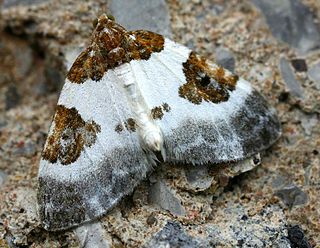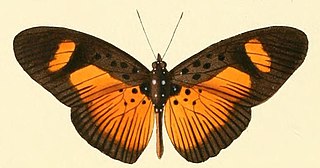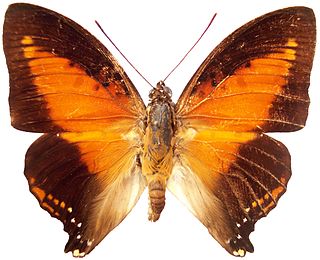
The brown hairstreak is a butterfly in the family Lycaenidae. The range includes most of the Palaearctic.

The Adonis blue is a butterfly in the family Lycaenidae. It inhabits the Palearctic realm.

Aporia crataegi, the black-veined white, is a large butterfly of the family Pieridae. A. crataegi is widespread and common. Its range extends from northwest Africa in the west to Transcaucasia and across the Palearctic to Siberia and Japan in the east. In the south, it is found in Turkey, Cyprus, Israel, Lebanon and Syria. It is not usually present in the British Isles or northern Scandinavia.

Polyommatus eros, the Eros blue or common meadow blue, is a species of blue butterfly found in the Palearctic.

Zygaena carniolica, sometimes described as the crepuscular burnet or eastern burnet, is a member of the family Zygaenidae.

Plemyria rubiginata, the blue-bordered carpet, is a moth of the family Geometridae found in Europe and across the Palearctic. The moth was first described by the Austrian lepidopterists Michael Denis and Ignaz Schiffermüller in 1775.

Polyommatus amandus, the Amanda's blue, is a butterfly of the family Lycaenidae. It is found in the Palearctic realm.

Chazara briseis, the hermit, is a butterfly species belonging to the family Nymphalidae. It can be found in North Africa, southern Europe, Asia Minor, the Caucasus, Kazakhstan, Central Asia through Afghanistan, and north-western China and Tuva. It is found on steppe and in other dry grassy places between 500 and 2,500 meters.

Zygaena purpuralis, the transparent burnet, is a moth of the family Zygaenidae.

Zygaena occitanica, the Provence burnet, is a moth of the Zygaenidae family. It is found from the Algarve and southern Spain up to the eastern parts of the Cantabrian Mountains then to southern Russia and the Caucasus and east to the western fringe of Central Asia.

Papilio ambrax, the Ambrax butterfly, is a butterfly of the family Papilionidae. It is found in Queensland, Australia, as well as the Aru Islands, Papua (Indonesia), and Papua New Guinea.

Pseudacraea eurytus, the false wanderer, is a butterfly of the family Nymphalidae. It is found in Africa.

Pseudacraea lucretia, the false diadem or false chief, is a butterfly of the family Nymphalidae. It is found in Africa.

Zygaena sarpedon is a moth of the Zygaenidae family. It is found in France, Italy and on the Iberian Peninsula.

Zygaena brizae is a species of moth in the Zygaenidae family. It is found in France, Italy, Austria, the Czech Republic, Poland, Slovakia, Hungary, the Balkan Peninsula, Moldova, Ukraine, Russia, Turkey and Georgia.

Zygaena punctum is a species of moth in the family Zygaenidae. It is found in Poland, the Czech Republic, Slovakia, Austria, Slovenia, Italy, the Balkan Peninsula, Moldova, Ukraine, Russia and Turkey.

Zygaena rhadamanthus is a species of moth in the Zygaenidae family. It is found in France, Spain, Portugal and Italy.

Charaxes zingha, the shining red charaxes, is a butterfly in the family Nymphalidae. It is found in Senegal, Guinea, Sierra Leone, Liberia, Ivory Coast, Ghana, Nigeria, Cameroon, the Republic of the Congo, Angola, the Central African Republic, the northern part of the Democratic Republic of the Congo, Uganda and western Tanzania. The habitat consists of lowland evergreen forests and sometimes gallery forests and coastal scrubland.
Colias aquilonaris is a butterfly in the family Pieridae found only on the Chukchi Peninsula in the Russian Far East and along the valleys of the rivers Olenyok and Yana.
Zygaena escalerai is a species of moth in the Zygaenidae family. It is found in Iran. In Seitz it is described - Z. escalerai Pouj. has orange spots on forewing, the external pairs being confluent; spot 6 is elongate and transverse. The hindwing is orange, with a vermilion tint, the disc being hyaline and the apex black, there being a black dot situated at centre of distal margin. The species has been discovered in Persia, the type contained in the Paris Museum being caught by Escalera [Manuel Martínez de la Escalera] in July. According to the description this form is allied to the fraxini-truchmena group.


















